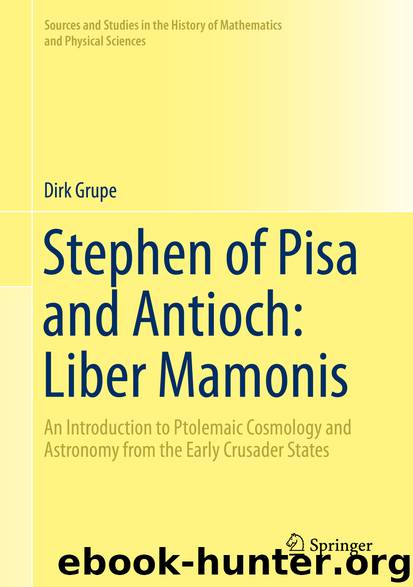Stephen of Pisa and Antioch: Liber Mamonis by Dirk Grupe

Author:Dirk Grupe
Language: eng
Format: epub
ISBN: 9783030192341
Publisher: Springer International Publishing
Fig. 3.10From MS Cambrai 930, fol. 36r. Labels: “the sun” (sol), “first <visible moon>” (prima), “half <moon>” (semis), and “full <moon>” (plena)
But since the moon is often eclipsed and itself also sometimes inflicts evanescence on the sun, it is of great use to speak about the reason of these things and when it occurs. We will first deal with the solar evanescence and afterwards with the lunar eclipse.
In this matter, one must imagine a line from the centre of the world and a circle that passes through [that line’s] point on the high sphere, and we should keep in mind how the moon’s latitude and longitude change. For the moon moves by a combination of the motions which it has, some of which tend eastwards and some westwards, but by the speed of the deferent sphere, and sometimes enhanced by the epicyclic sphere, as we have said, it moves eastwards, as is the order of the signs.
[249] Also the imaginary line, which originates from the centre of the world and is directed straight to the centre of the moon and is extended until the surface of the high sphere and terminates on the inclined circle, is moved by the motion of the moon, touching sometimes these, sometimes other points of the inclined circle. [250] By the same motion also the circle is moved which runs through the poles of the ecliptic and through the point that is touched by the line, 143 and which divides the inclined circle and the ecliptic into two halves. It results from this that the point in which it crosses the zodiac moves. This is the motion of the lunar body which we observe to occur in longitude of the ecliptic. [251] But that motion by which the line that is directed straight from the centre of the world, through the centre of the moon, to the inclined circle is sometimes moved to the south and sometimes to the north, is called the observed motion of the moon in latitude. For it is by this motion that the length of the arc that is between the two circles, namely the inclined circle and the ecliptic, changes and is sometimes found increasing, often decreasing, and occasionally not existent at all. It follows from this that the latitude of the moon varies, being sometimes larger, sometimes less, and often nil.
[252] When by the motion of the deferent sphere that intersection point moves, in which the ecliptic and the circle through its poles and also the end of the line which cuts through the latter and the inclined circle 144 divide each other, the body of the moon will also move in longitudinal direction. But when it has reached the circle that passes through the poles of the ecliptic and the centre of the sun, the circle that runs through the centre of the moon and the circle of the sun become one; and when the two lines, 145 which both originate from the centre of the world
Download
This site does not store any files on its server. We only index and link to content provided by other sites. Please contact the content providers to delete copyright contents if any and email us, we'll remove relevant links or contents immediately.
Tools of Titans by Timothy Ferriss(7814)
Turbulence by E. J. Noyes(7701)
Astrophysics for People in a Hurry by Neil DeGrasse Tyson(5002)
Secrets of Antigravity Propulsion: Tesla, UFOs, and Classified Aerospace Technology by Ph.D. Paul A. Laviolette(4992)
Design of Trajectory Optimization Approach for Space Maneuver Vehicle Skip Entry Problems by Runqi Chai & Al Savvaris & Antonios Tsourdos & Senchun Chai(4841)
Room 212 by Kate Stewart(4739)
Pale Blue Dot by Carl Sagan(4617)
The David Icke Guide to the Global Conspiracy (and how to end it) by David Icke(4380)
A Journey Through Divination and Astronomy by Publishing Pottermore(4250)
Apollo 8 by Jeffrey Kluger(3512)
Goodbye Paradise(3446)
Losing the Nobel Prize by Brian Keating(3425)
COSMOS by Carl Sagan(3348)
The Five People You Meet in Heaven by Mitch Albom(3335)
How to Read Water: Clues and Patterns from Puddles to the Sea (Natural Navigation) by Tristan Gooley(3240)
Brief Answers to the Big Questions by Stephen Hawking(3239)
How to Read Nature by Tristan Gooley(3078)
The Order of Time by Carlo Rovelli(3073)
A Brief History of Time by Stephen Hawking(2819)
